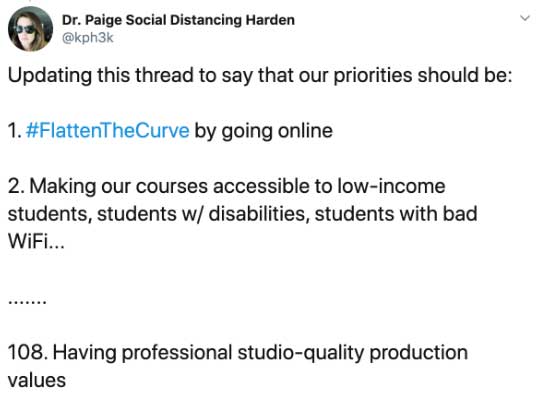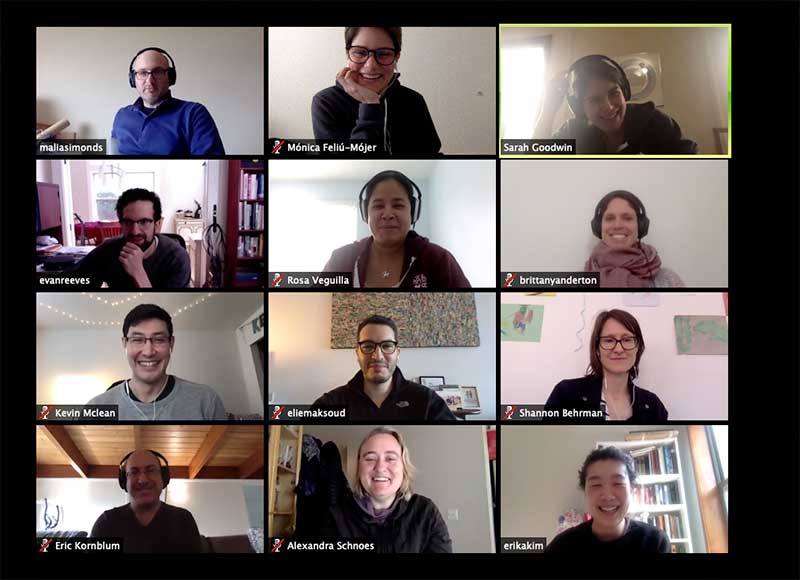Are you among the thousands of educators suddenly thrust into online teaching? Here at iBiology, we’ve thought deeply about ways to promote active learning online. We’ve built courses from the ground up and designed video-based curricula that educators can integrate into their own courses (check out our Professional Development Online Courses, Flipped Courses and Microscopy Series, for example). All that to say, we understand the challenge ahead, and we’ve got you! Our team has assembled some tips, tricks, and thoughts that we hope will help you through this process.

Perfect is the enemy of the good
If you’ve found yourself inspired (or intimidated) by the myriad online courses that have emerged with increasingly high production values. Stop. Online courses that were conceived as such often have entire teams of people to create them. And time. And money. Sure, take some ideas from things you see, but place your focus on the critical elements of your class to work. We’re following the lead of Rebecca Barrett-Fox on this point. This is one very large unexpected educational experiment that we are all about to engage in. Be gentle with the demands you place on yourself.

Break down your goals and set realistic expectations
This is a non-proverb-based extension of the previous point. Return to your syllabus or any other planning you did in the creation of your course to think about the learning outcomes you seek for your students. Take a look at the assignments, tests, quizzes, and any other assessments to see how they need to be tailored to an online space. This article, “Going Online in a Hurry” has some great advice on this.
Check out the resources your institution has at its disposal
It is likely that your institution is or has already developed some guidance in terms of going online. Many institutions have also posted this information. Check out this amazing compiled list of remote teaching resources. You may already use Blackboard, Canvas, or other learning management systems to post course materials or moderate online discussions. Your institution might have licenses to Zoom, Webex or other video conferencing capabilities, but if not you may be able to access these tools for free right now. Take some time to poke around and see whether there are any additional features that you may have missed (such as the Canvas Studio video quiz option).
Block off time to learn the new technologies
If the technologies you are going to use are new to you, try to make dedicated time to know the ins and outs of the technology. It will help you feel more comfortable with the process. Also, many students will likely have the same questions and issues. For all the technologies you are using there are likely many articles or youtube videos that already exist to help you out. This can keep your online teaching from getting sidetracked into dealing with technical issues and focused on helping your students learn.
Find online resources that work for you
There are many organizations (like us!) that are already making free, online educational resources. These may help supplement your lectures or provide a basis for discussion. Here are some reputable resources we recommend:
- iBiology videos, educator resources and courses
- LabXchange
- The Explorer’s Guide to Biology (XBio)
- HHMI BioInteractive
- JoVE Science Education
- CourseSource
Some of these resources, like iBiology and BioInteractive, allow for free downloading of the content or videos, which can be helpful in cases where consistent internet is a problem. There is also a growing list of crowdsourced resources for different disciplines that is being created. There is also free software you might want to use. If you want to make online videos more interactive by embedding narration and discussion questions, EdPuzzle offers a free basic plan for educators and students. For facile chat discussions, you might want to use the free version Slack. Or for sharing different types of creative work, you might want to use Padlet.
Determine how to schedule your class
Decide whether it makes sense to have your class meet at a regular time (synchronous) or if you want your class to be on-demand (asynchronous). Both are viable options, but require different preparation. In a synchronous course, you get the benefit of having active virtual discussions and also greater accountability because you are compelled to meet at a certain time. However, an asynchronous course provides more flexibility for students who may have to adjust their schedules for other important responsibilities (working, taking care of family), who may not have reliable internet, or who may now be in a different time zone. You could also hold a real-time synchronous class that gets recorded so that you have an archived version of the course. Zoom and Google Hangouts Meet both allow for this quite easily.

Think of accessibility
Keep in mind that students may not have the same internet options at home as they would on campus. This might influence whether you choose to hold class in real time that may require bandwidth-heavy video streaming. Also consider the adaptive learning mechanisms that students with disabilities might use for in-person classes, and how those might translate for an online class. Your institution will hopefully have identified ways for you to support different learners’ needs, and here are a couple resources that might be helpful:
Don’t obscure your voice
A big part of what makes you an effective educator is YOU. Don’t lose yourself in online materials. If you’re not meeting face to face, record or write an introduction to your course and/or materials that connects you to your students. Don’t be afraid to share your pets or personal elements in your life that you feel comfortable with. Many instructors will likely end up wrangling stuck-at-home children and teaching at the same time, or navigate any number of other unexpected interruptions. This is a feature, not a bug! In the impersonal world of self-isolation, it’s nice to know you’re learning from a real human.
Put labs online
Although it is hard to substitute wet lab experience, members of the Society for the Advancement of Biology Education Research (SABER) have been quick to suggest ways to promote quantitative reasoning and hypothesis testing online. See Sarah Miller’s resource compilation as a starting point.
Be a source of clarity and transparency
Be as clear as possible when giving instructions on how to navigate course materials and assignments and be prepared to make yourself more digitally available to answer questions. If you choose to record videos or lectures, watch through them before or after they are posted. I know, it can be awful to see or hear yourself speak, but get an idea of how things are coming across as you go so that you can incorporate any necessary changes along the way. Also, if there are certain things that are not clear to you now, in terms of course plan, materials or deadlines, don’t be afraid to communicate that uncertainty to them. More than anything, students are going to need to know that you are communicating with them as best you can, and are working towards getting answers to questions and solutions to problems that might feel currently daunting.
Be kind to yourself, in addition to your students
You have likely already been thinking about the massive disruption this is causing in your students’ lives, not to mention your own. Moving to an all online educational experience would always be difficult, but the context in which this is happening (global pandemic!) is particularly stressful and anxiety-producing. Be prepared that things are not going to work smoothly. There will be frustrations. Many students may not have access to reliable internet. Some may struggle deeply with the new online format. People we care about may become seriously ill. This will have a psychological toll on your students, and yourself. Flexibility is key, for both you and your students. And remind yourself that, most of the time, actions come from best intentions, even when things may seem a little messy. Let yourself off the hook a little.
Evaluate for yourself, for the future
Teaching online, like anywhere else, is an iterative process. Take some time to debrief after each class/module/course to see what you felt worked and what could be changed. Write notes to yourself, so you remember later. Without getting too end-of-times about it all, you develop useful skills and experience taking your course online, and this probably won’t be the last time you use them.
We’ll leave it there for now, we hope that you find these thoughts helpful as you prep for the coming weeks. Feel free to let us know if you have any other ideas you want to share or if there is anything you think we should change or expand in our list.






Ronel Barlow says
Thank you so much for this excellent advice! I have often found the most amazing lectures on iBiology but I hope to explore more that this website has to offer when we change to online learning.
Anjana Saxena says
Excellent tips to convert this ‘emergency adaptation’ to an ‘easy’ one! Will definitely share with my colleagues.
Anjana Saxena says
Excellent tips to convert this ‘emergency adaptation’ into an ‘easy’ one! Will definitely share with my colleagues.